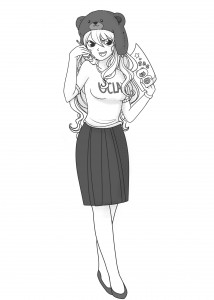Smooth, white chalk lines danced across the black chalkboard as Melinda Chiem-Ngoy sketched different parts of an anime character, emphasizing the need for attention to anatomical details.
The third-year psychology student teaches manga drawing to a group of students who gather weekly in UCLA’s Jamba Juice to practice drawing Japanese comics. Manga is a medium commonly seen as a significant part of Japan’s modern pop culture.
The group of artists, who call themselves Fresh Produce, are an offshoot of UCLA’s Japanese Anime Club, said Chiem-Ngoy, also the vice president of Fresh Produce.
“We want to get more people into making anime-related art,” Chiem-Ngoy said. “We want to help endorse the Western anime art community that has been spreading rapidly in recent years.”
In addition to creating anime and manga-related art, Fresh Produce members also hold manga-drawing tutorial sessions at the beginning of their meetings.
“We usually spend each week teaching members how to draw specific parts of the human anatomy,” Chiem-Ngoy said. “We hope that by teaching people to draw manga, we can get them to enjoy creating manga and anime-inspired art, too.”

Chiem-Ngoy added that once she has taught students how to draw human anatomy, she hopes to teach people how to create good manga layouts that bring the full impact of various types of settings to readers.
Fresh Produce was formed in the mid-2000s by club members who wanted to use their drawing talents to collaborate with others to create anime and manga-inspired art, said Loi Le, a UCLA alumnus and past officer in the Japanese Anime Club.
Le said the group eventually became its own student organization, but is still closely connected to its roots at the Japanese Anime Club.
Today’s Fresh Produce members continue some of the same yearly traditions that the club started with, including compiling an anthology of their art. The project is meant to give a snapshot of the development in their anime and manga skills throughout their tenure as artists at UCLA, Chiem-Ngoy said.
She added that they usually sell the year’s anthology in the second half of spring quarter when the books arrive, with proceeds going to the purchase of art supplies for the club.
While the anthology is typically marketed with the Japanese Anime Club and Fresh Produce members in mind, anyone is welcome to buy a copy, Chiem-Ngoy said.
Since the club’s beginnings, Fresh Produce has grown in size and increased the variety of its activities.
Le said the Fresh Produce of his time was made up of a small group of artists who focused on their anthologies. Now, the club is bigger and more active. He added that the club also puts on a variety of anime-related events now, such as costume-making sessions.
Le credits Fresh Produce’s recent expansion to its current officers.
“The officers this year are more active and vocal in leading the club,” he said.
Linh Nguyen, a fourth-year psychology student, said she was drawn into the manga-drawing world as a 7-year-old. As a child, she tried to make a fan-drawn comic of the anime series Cardcaptor Sakura.
While some people attend club meetings to learn more about drawing manga, Nguyen attends not only because she wants to improve her art, but because she enjoys the company of fellow club members.
“Melinda introduced me to Fresh Produce last year,” Nguyen said. “I became a member because I wanted to improve drawing and because the anime-loving members of Fresh Produce makes the club such a supportive and encouraging environment for artists.”
